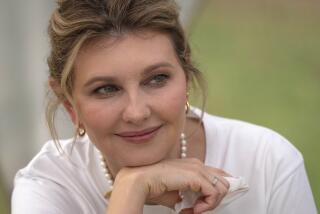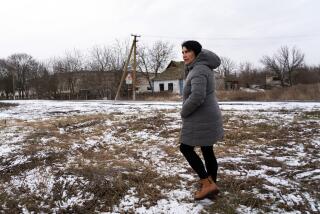Honor Is Gone for a Soviet Heroine
KULYAB, Tajikistan — Two dead children, one invalid, one who left for the capital, fate unknown. One unemployed, one in the army, and three working in the cotton fields of Tajikistan, where they get paid twice a year, in grain. And one schoolteacher.
The fates of the 10 children of Kholbi Musoyeva tell a bigger story of what has happened to the people of Tajikistan and other parts of Central Asia in the decade since the collapse of the Soviet Union.
Raising 10 children in Soviet times was an act of heroism--and was formally recognized as such. There were medals and benefits for the “Heroine Mothers.” There was honor.
Even more heroic was working 12 hours a day picking cotton with bleeding, torn fingers and all those children to look after.
Musoyeva, 55, is married to the brown earth of Tajikistan as surely as she is tied to her husband, Musafar Madisoyev, 64.
She began working in the fields at age 10, filling and hauling 45-pound bags of cotton while her mother filled 55-pound bags. With her feet in the dirt and bright scarves tied over her face to keep the sun and dust away, she has seen the cotton fields claim more hours of her time than any of her children ever could. The soil is an inescapable presence in her life.
Beginning in 1944, women with 10 or more children were named Heroine Mothers as part of an effort to relieve a labor shortage and increase the Soviet population, decimated by World War II, famine and the gulag.
Heroine mothers got free bus rides and cheap or free food.
“Those medals were very important in a person’s life. The Soviet government really helped families with lots of children,” Musoyeva recalled.
She was awarded four Soviet medals in all, including ones recognizing her as the hardest worker in the Rodina, or Motherland, collective farm. For this she was presented with money and gifts such as teapots, cups and rugs, which, despite their coarse quality, are the grandest items in her house today.
Home Is Nearly Bare, TV and Fridge Broken
Twenty-five years ago, the family had the trappings of an ordinary Soviet life. They bought a television. They had a gas stove, a refrigerator.
They still have them. But the TV and the fridge don’t work. There is no gas for the stove, so they cook over an open fire.
The home is nearly bare of furniture. In a corner stands the cradle where many babies were rocked. The curtains, shredded with age, look like lace.
The taps work for two hours a day, during which the family draws water for its daily needs. The electricity is on for a couple of hours a day.
Musoyeva sat on a worn rug on the whitewashed veranda of her home, as flies buzzed about a disk of unleavened bread and a bowl of fermented milk.
A dried, prickly twig hung in the doorway, so that whoever enters will be distracted and cast no ill on the family.
Musoyeva’s descriptions of life are sparse and hesitant: In shimmering heat, she must peer through a small slit in her tight-wound face scarves, reaching for the next bud of cotton. From 7 a.m., when she starts picking, a dull ache rises in her back, as the large sack fills and weighs down her neck. There are mosquitoes, there is dust.
But the overwhelming hardship is inflicted by the prickly cotton pods.
“They cut your fingers like a knife. We’d tape our fingers with insulation tape. We’d make gloves out of our children’s old trousers. But it doesn’t matter how many years you’ve picked cotton or how callused our hands are, they cut you anyway,” Musoyeva said. The pickers douse their fingers in soothing kerosene each night.
Musoyeva and her husband still pick cotton and work in the fields. Their pensions are too meager to live on, so they must work.
The cotton workers take lunch on the roadside, eating gray wheat porridge from common wooden bowls. The old men eat first. The women hold back.
For poverty-stricken cotton workers, the only difference between the new independent Tajikistan and the old Soviet republic of Tajikistan is that, materially, they were better off then.
Musoyeva and her husband, grinding through their days in the fields, say they were not aware of the suppression of dissidents during Soviet times.
And no wind of freedom or democracy has blown through Tajikistan since. The country was racked by civil war until 1997. Western observers strongly criticized the presidential elections in 1994 and 1999, won by Emamali Rakhmonov, for flagrant fraud.
One of the main aims of the Soviet Heroine Mothers policy was to increase birthrates, particularly among Russians. But most of the Heroine Mothers were in the Muslim republics of Central Asia, such as Tajikistan, Uzbekistan and Turkmenistan, where large families were traditional.
Having many children was almost a form of wealth. Sons and daughters would look after you in your old age.
But for this family, it turned out the other way around.
“Now we have to help them. Our children work in the collective farm and get nothing. They can’t help us,” Musoyeva said.
“In Soviet times we gave birth to our children willingly, but if we had known what kind of life awaited us today, we would never have done it,” she said, with soft bitterness.
With their parents in the field, Musoyeva’s children spent the day in a collective farm’s kindergarten and later at school. They started doing domestic work at age 6. The older girls rose at dawn to prepare food for all the children. They swept and tidied the house. Even the youngest ones hauled water in kettles.
The lives of her three sons and seven daughters reflect the country’s social and economic problems with uncanny precision.
A 25-year-old son is unemployed and unmarried; another is in the army but likely to be unemployed when he completes his service; another son, 24, went to the capital, Dushanbe, and the family does not know what became of him. That he never returned or sent money is a bad sign in Tajikistan, with its close-knit families and kinship traditions. At best he is unemployed; at worst he is homeless or dead.
Of the five surviving daughters, four are working, three in the cotton field.
Two Daughters Died Preventable Deaths
Testament to the poor health services in Tajikistan were the preventable deaths of two other daughters, one from epilepsy and the other in childbirth. The youngest daughter, 14, is disabled and will never attend school or work because a bungled operation left her incontinent.
Musoyeva’s own health is poor. She feels the strength seeping out of her body. Though it is hot, she wears a heavy woolen vest, saying she can’t keep the chill out of her bones. Back pain is ever present--it’s the cotton pickers’ fate--and she has trouble standing up.
Historically, health problems and a high infant mortality rate in Tajikistan were partly attributed to inadequate diet, because of the emphasis on growing cotton instead of food, and to the highly toxic defoliants and pesticides used.
DDT is no longer used to kill mosquitoes here, but that means malaria has reemerged. Typhoid and cholera are rife because of the lack of clean water and sewage facilities.
Although Musoyeva and her husband remember Soviet power as benevolent, by 1987 the authorities had in fact lost their enthusiasm for high birthrates in Tajikistan.
The Central Asian republic by then had 30,000 Heroine Mothers, declining living standards and social services, and not enough jobs to occupy the work force.
The authorities tried unsuccessfully to curb the birthrate. Articles were placed in Tajik newspapers claiming that a fifth or sixth child could harm both mother and unborn child.
With low birthrates among Russians, part of the concern in Moscow was over the population balance in the rest of the Soviet Union, and demographers’ predictions that an Asian, predominantly Muslim majority would emerge.
Central Asians were barely represented in the Moscow power structures, but there was resentment and criticism of Tajikistan as a republic that did not pull its weight, due to high population growth and underemployment.
But the population control campaign had little success: A 1988 survey of young Tajik men found that 29% wanted to have seven to 20 children, or even more.
In any case, with the Soviet collapse three years later, Musoyeva’s Heroine Mother medals were suddenly transformed into useless bits of metal, toys for the children, soon scattered and lost. All the benefits evaporated.
Musoyeva suffers deep poverty and works hard. In her life, she had little time for her children, who also suffered and worked hard. She was a Soviet heroine, but she seems uncertain whether any of this constituted real heroism.
She regrets the sacrifices she had to make.
“We would have liked to have taken better care of our children. But we had to work in the collective farm. There was no other way to make money. We had to survive.”
More to Read
Sign up for Essential California
The most important California stories and recommendations in your inbox every morning.
You may occasionally receive promotional content from the Los Angeles Times.










